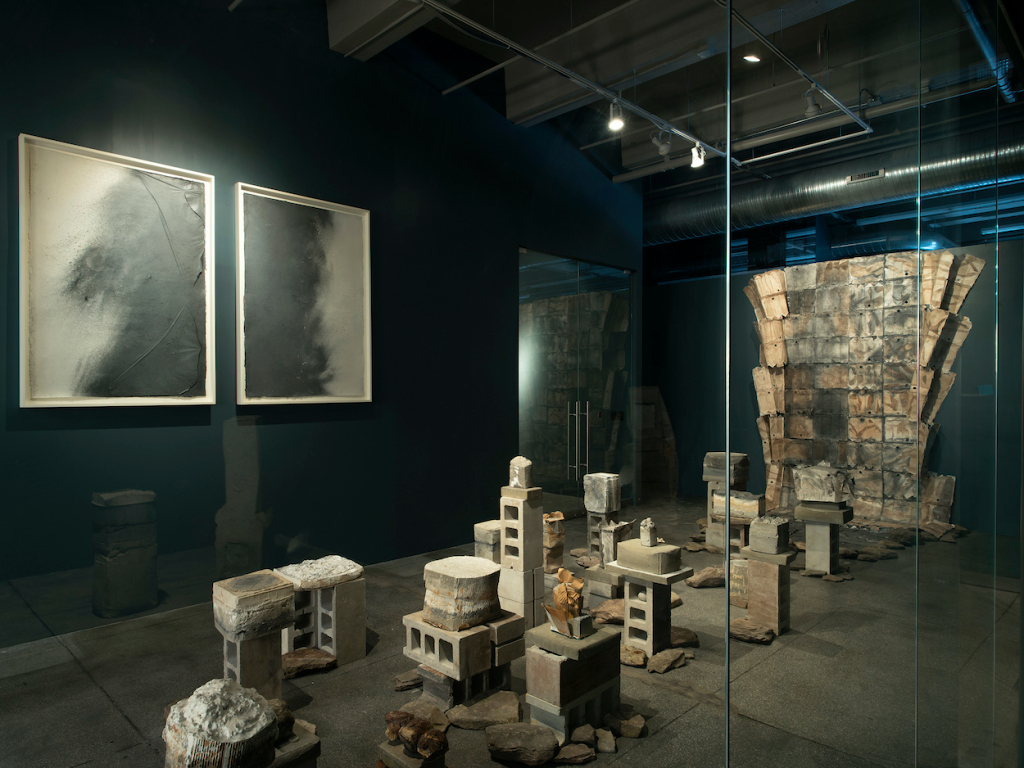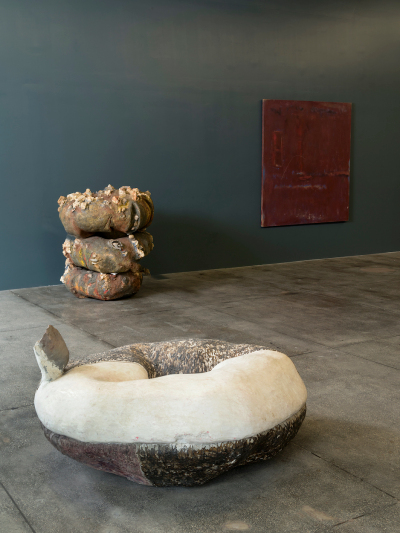 View of “Transcending Fields,” 2021, at Mana Contemporary, showing Earth and my New York Rocks, 2017–18; Layers Rise/Rising Pathways, 2016–17; and Envelope/Envelop 3/4, 2004–15. Photo: John Berens. Courtesy Mana Contemporary.
View of “Transcending Fields,” 2021, at Mana Contemporary, showing Earth and my New York Rocks, 2017–18; Layers Rise/Rising Pathways, 2016–17; and Envelope/Envelop 3/4, 2004–15. Photo: John Berens. Courtesy Mana Contemporary.
The title of Mana Contemporary’s survey of New York–based artist Ruth Hardinger, “Transcending Fields,” suggests elevation or sublimation. And yet, while the exhibition’s low lights, pools of shadow, and pilgrimage-like structure establish a quietly spiritual sense of ascent, the fifty-year practice it represents belongs much more to the profane world of dirt and gravity.
One obvious through line unites Hardinger’s varied works in plaster, concrete, cardboard, rope, and graphite: an exquisite care for texture, tactility, and the brute physics of solids and surfaces. Two sculpture series on view, both dated 2006-18, employ “poor” or post-consumer materials. For “Envoys,” Hardinger casts concrete in cardboard molds ill-equipped to bear the weight: the resulting forms buckle and bulge as they stand upright or occasionally lie abjectly on the ground. Many of the smaller “Conundrums” are built up from stacked or nested concrete casts of items like plastic cups and milk cartons; they offer more playful studies in tension and balance. Even in Hardinger’s works on paper, material takes command: paper supports assume a dimensional heft as they fold, crumple, and crinkle, and powdered graphite billows smokelike across pulp.
Much of Hardinger’s oeuvre, curated here by Xiaokun Sunny Qiu, evinces her early absorption of the Post-Minimalist and Conceptual art traditions. While stated influence Sol LeWitt is clearly invoked in the 1974 drawing 72 of 74, which comprises a serial array of graphite rubbings, the mark of Eva Hesse, another artist Hardinger admires, is legible in the sprawling rope installation, titled Carriage Constellation (2010), filling one whole room of “Transcending Fields.” The specter of Robert Morris, whom Hardinger knew, pervades much of the exhibition, with its repeat investigations of process, contingency, and weight. But Hardinger’s work begins to drift from this network of references when read in relation to the artist’s most enduring muses: environmental trauma and Mesoamerican history. The former interest, more recent, finds frequent expression in her choice of materials. The presence of shale in several works signals the artist’s acute concern for the consequences of fracking, and the “Envoys” series, with its aggregations of concrete and cardboard, invites interpretation as weathered fossils of modern industry.
 View of “Transcending Fields,” 2021, showing Divided Count, 1992. Photo: John Berens. Courtesy Mana Contemporary.
View of “Transcending Fields,” 2021, showing Divided Count, 1992. Photo: John Berens. Courtesy Mana Contemporary.
Hardinger’s interest in Mesoamerica was kindled in 1969, when she traveled to Mérida, a town on the Yucatán Peninsula, via a college exchange program. There, in the presence of Mayan ball courts and corbel vaults, she was first drawn to pre-Columbian cultures for their architecture and monuments as well as the cosmologies underlying those forms. Hardinger returned to Mexico in 1991 on a Fulbright grant; during a productive yearlong stay in Oaxaca, she established relationships with Chontal and Zapotec weavers, and worked extensively with a variety of indigenous materials. Fresco, adobe, beeswax, and cochineal distinguish the rich surfaces of two exhibited sculptures that grew out of these travels—the imposing, four-foot-wide, donut-shaped Divided Count (1992) and the fleshy, ballooning Suerte de Animales (1992).
This Mesoamerican influence is the aspect of Hardinger’s work that demands the most delicate engagement, given the long tradition of European and North American artists selectively sampling “exotic” practices and cosmologies, and leaning on a tension between modern forms and ruinous emblems of supposedly vanished cultures. At her best, Hardinger refreshingly subverts this dynamic. The works she created in collaboration with Latin American makers—for example, the brilliant wool tapestries designed and produced on an upright loom with father-son Zapotec weavers Alberto and German Vásquez—justly credit them as co-creators by featuring their initials alongside her own. Among the most vibrant works in “Transcending Fields,” these tapestries testify not to distant pasts and cultural salvage, but rather to living traditions and the continuity of Indigenous knowledge.
Staring down imminent ecological collapse, and balancing a freight of worldly concerns while conducting rigorous material investigations, Hardinger does not allow us to transcend—not completely. To her credit, her work holds us tight to the ground, where there is still plenty of work to be done.
Source link : https://www.artnews.com/art-in-america/aia-reviews/ruth-hardinger-mana-contemporary-1234600838












